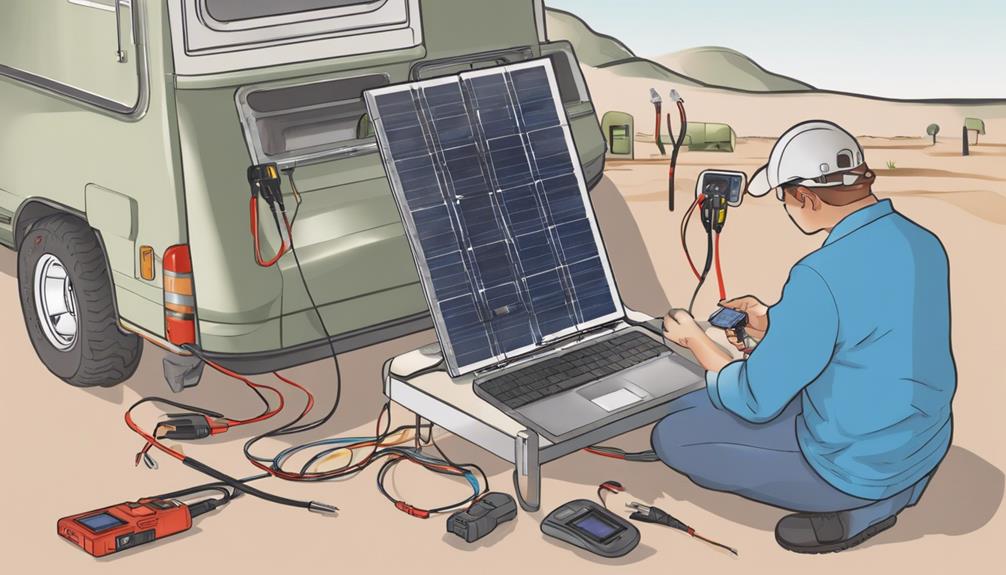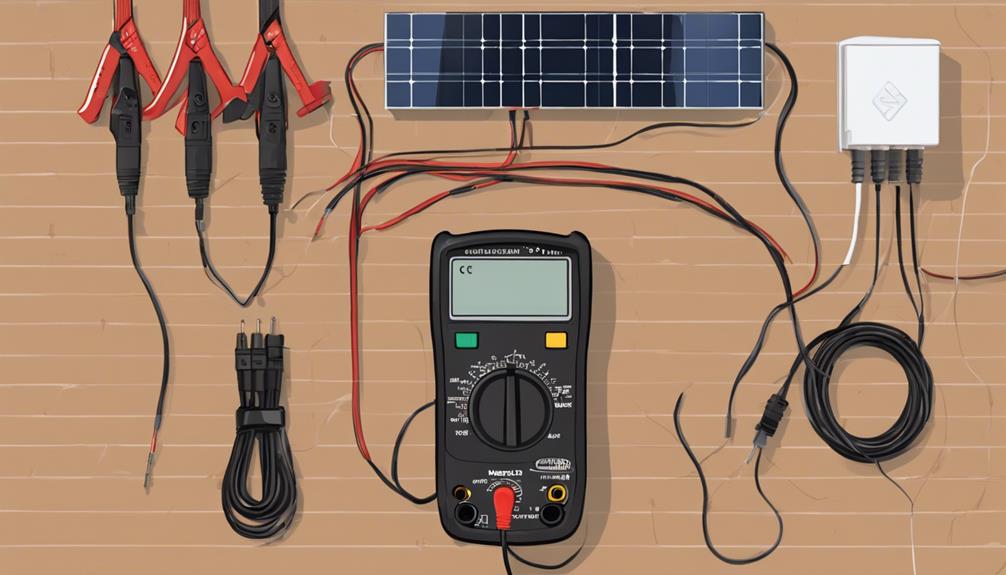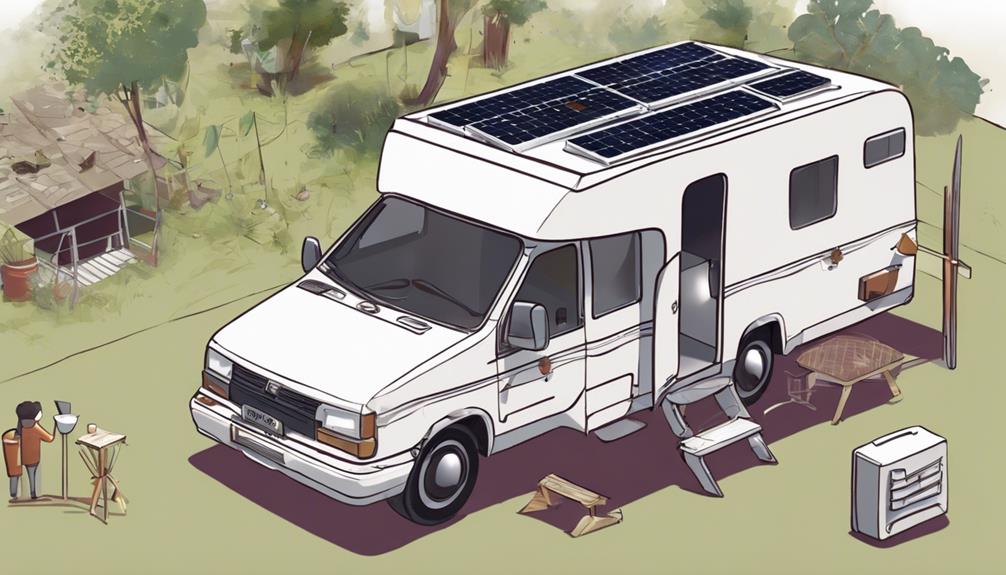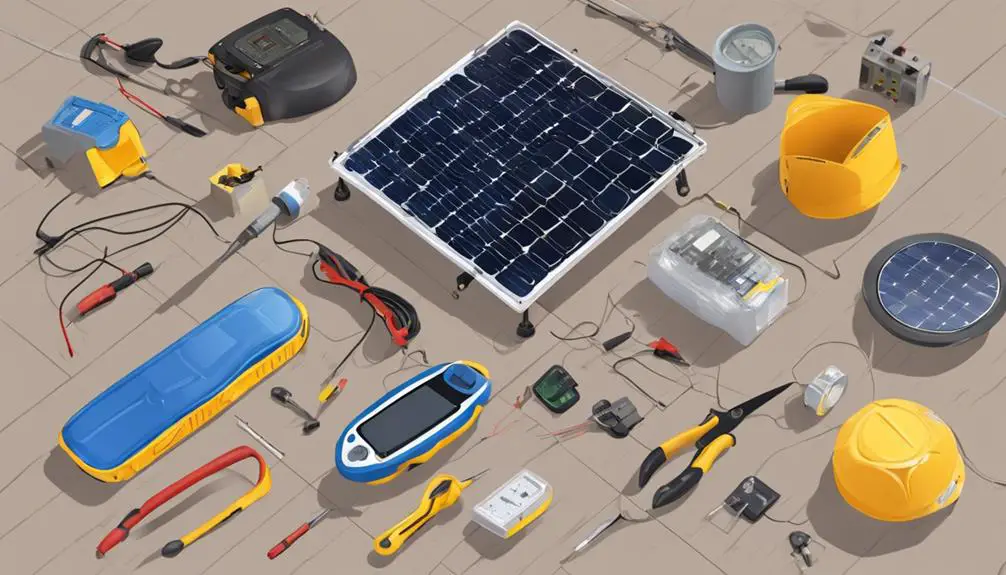When troubleshooting caravan solar panels, guarantee connections are tight, check battery charge levels using a digital voltmeter, analyze solar controller data, and inspect inverter function. Verify panel orientation for best sunlight exposure. Secure inverter and battery connections, clean for efficiency, and monitor voltage levels. Position panels correctly and adjust angles for maximum sun exposure. Inspect grounding connections for integrity and proper installation. Testing and maintaining these components can assist in detecting and resolving any issues with your caravan solar panel system.
Checking Solar Panel Connections

Strengthen all solar panel connections are firmly fastened to prevent any power loss or malfunctions. Begin by carefully checking wiring connections to guarantee proper voltage output. Inspect each connection point for any signs of looseness, corrosion, or damage. Tighten any loose connections using appropriate tools to maintain a secure electrical contact.
Next, verify the panel orientation to maximize sunlight exposure. Ensure that the panels are facing the correct direction to receive best sunlight throughout the day. If needed, adjust the tilt angle of the panels to align them properly with the sun's position. This adjustment can significantly enhance the efficiency of your solar panels and boost their overall performance.
Testing Battery Charge Levels
Inspecting the battery charge levels using a digital voltmeter to evaluate the current state of power storage in your caravan's solar system. Begin by setting the voltmeter to the DC voltage setting.
Connect the red probe to the positive terminal of the battery and the black probe to the negative terminal. Take note of the voltage readings displayed on the voltmeter. A fully charged battery should read around 12.6 to 12.8 volts. If the reading is below 12.4 volts, the battery may require charging to maintain peak performance.
Regularly checking the battery charge levels is essential for preserving battery health. Over time, batteries can lose their capacity to hold a charge effectively. By monitoring the voltage readings, you can identify any potential issues early on and take necessary actions to prevent damage to the battery and optimize a steady power supply for your caravan's electrical systems.
Assessing Solar Controller Functionality

To evaluate the functionality of your caravan's solar controller, analyze the data displayed on the controller's screen for accurate readings of solar input, battery charge levels, and system performance.
Begin by testing the voltage output of the solar panels using a multimeter. Connect the multimeter to the solar panel terminals to verify that the voltage matches the expected values based on sunlight intensity.
Next, calibrate the settings on the solar controller to optimize its performance. Check that the battery charge levels indicated on the controller align with the actual state of charge to prevent overcharging or undercharging.
Monitor the system performance metrics such as input current and battery voltage to detect any irregularities that may indicate a malfunction.
Troubleshooting Inverter Issues
Ensure that the inverter's connections are securely fastened to troubleshoot potential issues with its functionality. Inverter troubleshooting often revolves around power output and voltage fluctuations.
If your inverter isn't producing the expected power output, start by checking the DC input connections from the solar panels to the inverter. Verify that there are no loose connections or damage to the cables.
Next, inspect the AC output connections to the caravan's electrical system. If the power output is still low, consider performing maintenance on the inverter. Dust and debris can accumulate over time, affecting its performance. Clean the inverter according to the manufacturer's instructions.
Additionally, voltage fluctuations can indicate potential issues with the inverter. Monitor the voltage levels during different times of the day to identify patterns. If you notice significant fluctuations, it may be necessary to consult a professional for further diagnosis and repair.
Regular maintenance and monitoring are essential to ensure the inverter operates at its best.
Inspecting Panel Placement and Angle

Position your caravan solar panels to maximize exposure to sunlight for best efficiency. To optimize efficiency, adjust the tilt of your panels to make sure they're facing the sun directly. The ideal angle varies depending on your location, so consider using tools like a solar angle calculator for precise adjustments.
By aligning your panels correctly, you can significantly increase the amount of sunlight they receive, thereby maximizing energy production.
When inspecting the placement of your panels, be mindful of any potential shading concerns. Even small amounts of shading can greatly reduce the efficiency of your solar system. Trim back any overhanging branches or reposition objects that may cast shadows on your panels throughout the day.
By ensuring that your panels have uninterrupted exposure to sunlight, you can enhance the overall performance of your caravan solar setup.
Regularly monitoring and adjusting the position and angle of your caravan solar panels will help you maintain peak efficiency and energy production. By taking these simple steps, you can make the most out of your solar system and enjoy a reliable power source on your travels.
Resolving Grounding Problems
Inspect the integrity of the grounding connections on your caravan solar panels to guarantee proper functionality and safety. Proper grounding techniques are essential for ensuring the efficient operation of your solar panel system.
Begin troubleshooting grounding problems by checking all the grounding connections for any signs of corrosion, loose fittings, or damage. Make sure that the grounding wires are securely connected to the frame of the solar panels and the caravan.
To address voltage fluctuations, verify that the grounding system is correctly installed according to the manufacturer's guidelines. Utilize a multimeter to measure the voltage levels at various points in the grounding system to identify any irregularities.
If voltage fluctuations are detected, consider adding additional grounding rods or conductors to stabilize the system.
Safety precautions must be followed when working with the grounding system. Always disconnect the solar panels from the charge controller before inspecting or modifying the grounding connections. Use insulated tools and personal protective equipment to prevent electrical hazards.
Frequently Asked Questions
How Can I Protect My Caravan Solar Panels From Theft?
To protect your caravan solar panels from theft, consider security measures like installing anti-theft devices and implementing monitoring systems. These methods can help deter potential thieves and provide you with peace of mind while on the road.
What Maintenance Is Required for Caravan Solar Panels?
To maintain your caravan solar panels, establish a regular cleaning schedule to remove dirt and debris. Inspect panel positioning for best sunlight exposure. Conduct frequent inspections and wiring checks to guarantee proper functionality and prevent potential issues.
Can Extreme Weather Conditions Damage Solar Panels?
Extreme weather conditions like snow accumulation and hail damage can harm solar panels. Heat waves and prolonged UV exposure also pose risks. Regularly inspect and protect panels from these elements to maximize performance and longevity.
Are There Portable Options for Solar Panels for Caravans?
For your caravan, consider foldable and lightweight solar panel options. These solutions offer easy portability and efficient energy generation. Look for mounting solutions with adjustable angles for best sun exposure, ensuring maximum power output on-the-go.
How Do I Increase the Efficiency of My Caravan Solar Panels?
To increase your caravan solar panels' efficiency, adjust the tilt for best sun exposure. Minimize shading from objects like trees or buildings. Upgrade battery storage capacity for storing excess power. Install monitoring systems to track energy production.
Conclusion
To sum up, troubleshooting caravan solar panels involves:
- Checking connections
- Testing battery charge levels
- Evaluating controller functionality
- Addressing inverter issues
- Inspecting panel placement and angle
- Resolving grounding problems
By following these steps methodically, you can identify and resolve any issues with your solar panels to achieve peak performance while on the road.
Remember to always prioritize safety and consult a professional if needed for further assistance.
